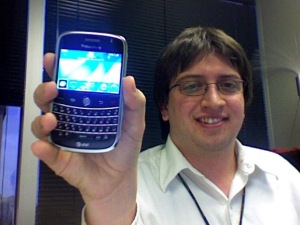
I used to have a BlackBerry—the ‘Bold’ 9000. I liked it quite a bit and, for its time, it was a fine phone. I very seriously considered replacing it with another BlackBerry but decided to give Palm another chance with its WebOS operating system. After Palm’s implosion, I ended up choosing Android.
Born out of the two-way pager universe, Ontario-based Research in Motion (RIM) always had a different approach to phones than its industry peers. When they were on top, they were up against three competitors whose phone operating systems all came from PDAs—Palm, Microsoft, and Symbian. The iconic BlackBerry phones from the era before the iPhone were simpler and less powerful than their competitors’ phones, but they were incredibly reliable and easy to use. There was no stylus to juggle with, no touchscreen to smudge, and a keyboard that was a true pleasure to thumb-type on. Once you got the hang of the trackball, it was a clean and efficient way of getting around the interface.
Unique among smartphones, and likely a holdover from their two-way pager background, BlackBerry phones are very reliant on RIM’s data center. Every other smartphone I’ve ever owned or used—ones running Palm OS, Windows Mobile 6, Palm WebOS, Google Android, and Apple iOS—communicated directly with the Internet, either over the phone network or a local wifi network. When I go to log into my corporate email on my Motorola Droid, or when I go to the CNN web site, those connections go directly from my phone, to the network, to the destination.
BlackBerry phones, however, send most of their network traffic through the RIM data centers. On a BlackBerry, your phone’s email app is connected via your phone or wifi network to RIM’s data center, which then connects to your email provider. Your phone is not directly communicating with your email service. When I had my BlackBerry, even basic Internet browsing all went through the RIM data center . . . though my understanding is that newer BlackBerry phones don’t have this problem.
This used to be a quirky little part of being a BlackBerry user. It had little real-world impact. But today, when consumers expect to be connected at all times, this outdated architecture is a damaging anachronism for RIM. When Google’s data centers go down, my Android phone and all of its non-Google apps still work and my corporate email will still load (though, of course, my Gmail wouldn’t). When Microsoft’s data centers go down, Windows Phone users can still go about their business uninterrupted. When Apple’s data centers go down, most iPhone users won’t even notice. But when RIM’s system crashes, as it did this week, BlackBerry users fall off the grid and lose many essential device functions.
It is clear that RIM’s whole architecture is broken. It is a leftover from a bygone time when phones weren’t powerful enough to deal with mail servers and web servers directly; a time when a go-between was an actual technical necessity. I pointed this out after an outage in December 2009, not long before I switched to WebOS, and it is very disappointing to me that RIM has still not learned its lesson.
The BlackBerry maker is struggling to keep up with its still-relatively-new mobile competitors at Apple and Google, not to mention a resurgent Microsoft. But the main threat to their success these days isn’t their competitors. No, RIM is hobbled by their their own apparent reluctance to move beyond being a go-between for two-way pager messages, and their failure to move fast enough to modernize the BlackBerry OS. As sales of BlackBerry smartphones continue to drop, relegating the once market-leading RIM to an also-ran in a world of iPhones and Droids, RIM has nobody to blame but themselves.

